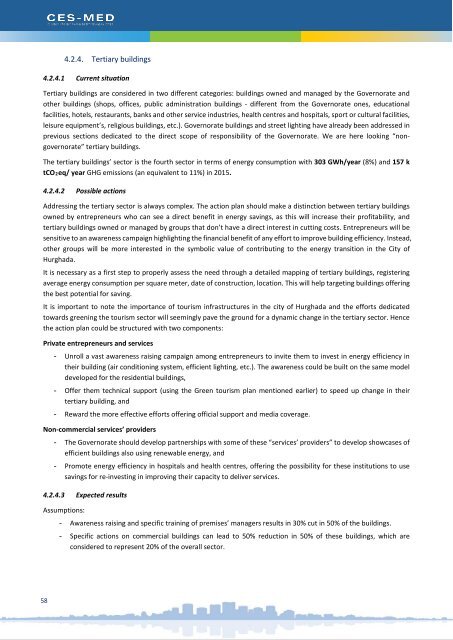020318_Hurghada SECAP_FINAL
You also want an ePaper? Increase the reach of your titles
YUMPU automatically turns print PDFs into web optimized ePapers that Google loves.
4.2.4. Tertiary buildings<br />
4.2.4.1 Current situation<br />
Tertiary buildings are considered in two different categories: buildings owned and managed by the Governorate and<br />
other buildings (shops, offices, public administration buildings - different from the Governorate ones, educational<br />
facilities, hotels, restaurants, banks and other service industries, health centres and hospitals, sport or cultural facilities,<br />
leisure equipment’s, religious buildings, etc.). Governorate buildings and street lighting have already been addressed in<br />
previous sections dedicated to the direct scope of responsibility of the Governorate. We are here looking “nongovernorate”<br />
tertiary buildings.<br />
The tertiary buildings’ sector is the fourth sector in terms of energy consumption with 303 GWh/year (8%) and 157 k<br />
tCO2eq/ year GHG emissions (an equivalent to 11%) in 2015.<br />
4.2.4.2 Possible actions<br />
Addressing the tertiary sector is always complex. The action plan should make a distinction between tertiary buildings<br />
owned by entrepreneurs who can see a direct benefit in energy savings, as this will increase their profitability, and<br />
tertiary buildings owned or managed by groups that don’t have a direct interest in cutting costs. Entrepreneurs will be<br />
sensitive to an awareness campaign highlighting the financial benefit of any effort to improve building efficiency. Instead,<br />
other groups will be more interested in the symbolic value of contributing to the energy transition in the City of<br />
<strong>Hurghada</strong>.<br />
It is necessary as a first step to properly assess the need through a detailed mapping of tertiary buildings, registering<br />
average energy consumption per square meter, date of construction, location. This will help targeting buildings offering<br />
the best potential for saving.<br />
It is important to note the importance of tourism infrastructures in the city of <strong>Hurghada</strong> and the efforts dedicated<br />
towards greening the tourism sector will seemingly pave the ground for a dynamic change in the tertiary sector. Hence<br />
the action plan could be structured with two components:<br />
Private entrepreneurs and services<br />
- Unroll a vast awareness raising campaign among entrepreneurs to invite them to invest in energy efficiency in<br />
their building (air conditioning system, efficient lighting, etc.). The awareness could be built on the same model<br />
developed for the residential buildings,<br />
- Offer them technical support (using the Green tourism plan mentioned earlier) to speed up change in their<br />
tertiary building, and<br />
- Reward the more effective efforts offering official support and media coverage.<br />
Non-commercial services’ providers<br />
- The Governorate should develop partnerships with some of these “services’ providers” to develop showcases of<br />
efficient buildings also using renewable energy, and<br />
- Promote energy efficiency in hospitals and health centres, offering the possibility for these institutions to use<br />
savings for re-investing in improving their capacity to deliver services.<br />
4.2.4.3 Expected results<br />
Assumptions:<br />
- Awareness raising and specific training of premises’ managers results in 30% cut in 50% of the buildings.<br />
- Specific actions on commercial buildings can lead to 50% reduction in 50% of these buildings, which are<br />
considered to represent 20% of the overall sector.<br />
58

















